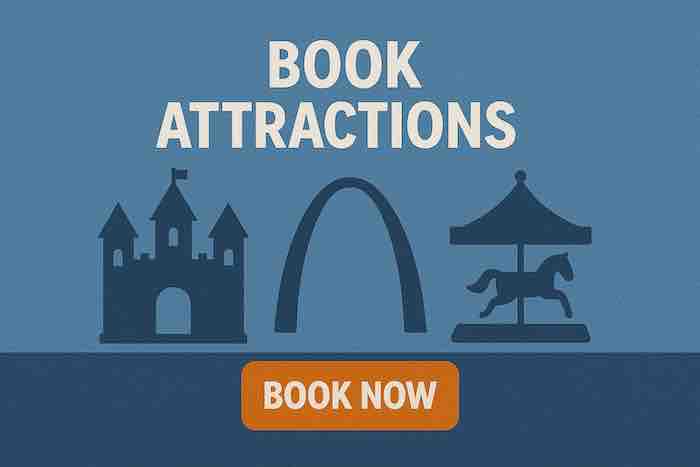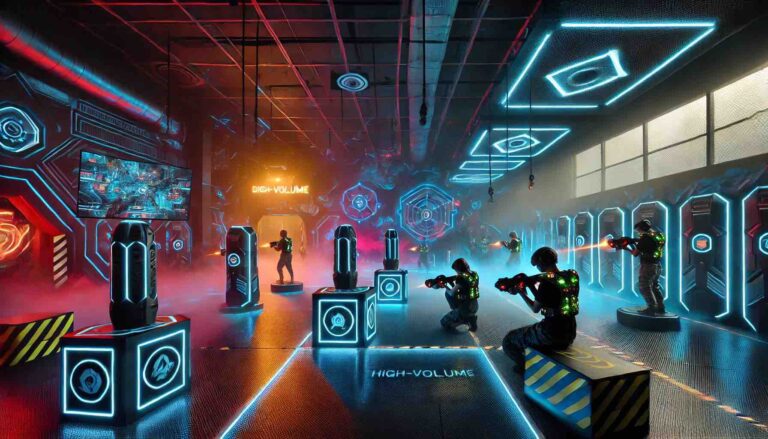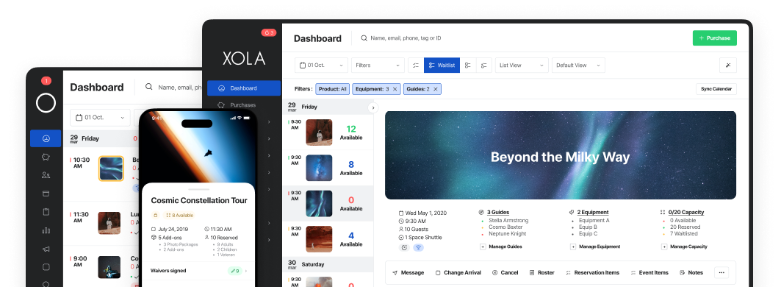
When you’re running a location-based experience—whether it’s a trampoline park, escape room, or go-kart track—getting people in the door is everything. And while third-party platforms can help fill time slots, relying on them alone means giving up revenue, control, and the direct relationship with your guests.
That’s where a strong direct booking strategy comes in.
In this guide, we’ll walk through 11 proven tactics to help you drive more direct bookings for your indoor attraction. These are practical, real-world strategies used by successful operators. And you can start implementing right away. From upgrading your website to building loyalty through email, we’ll show you exactly how to turn casual browsers into confirmed guests.
1. Revamp your website to create a seamless booking experience
Would you leave cardboard boxes and loose papers scattered around your reception area on the day of a big event? Probably not. Your website is no different—it’s the digital lobby of your attraction. If it’s cluttered with irrelevant pop-ups, grainy photos, or confusing language, guests will leave before ever. While the physical space of a location-based experience is of utmost importance, so is your online space. Visitors should be able to find your checkout button as easily as they see your venue’s front desk.
With that said, having a clean and intuitive website design is necessary to drive more direct bookings for your location-based attraction. This means big, bold photos that show off the best of your experience, paired with smart messaging that encourages visitors to take action. And navigation that makes it effortless to move from the homepage to booking. A well-placed “Book Now” button shouldn’t be an afterthought but the centerpiece.
Yet when we talk about revamping your site, we’re not only talking about design. From SEO and mobile optimization to simplifying your checkout flow, the back-end work is just as important.
2. Optimize for local SEO to increase visibility
Most of your guests are already nearby—they’re just a Google search away.
“Trampoline park near me.”
“Indoor things to do with kids.”
“Best escape room in Austin.”
These are the kinds of searches that should lead people straight to your doorstep. But if your website isn’t optimized for local SEO, you’re missing out on a considerable stream of direct bookings. The Google searches above will result in a list of trampoline parks, escape rooms, and indoor experiences whose operators have optimized their site for SEO.
Start with your Google Business Profile. Make sure it’s claimed, fully filled out, and updated with your hours, location, photos, and a direct booking link. Then, turn your attention to your website. Use city-specific keywords on your homepage and booking pages. Instead of “Book a game now,” try “Book your escape room experience in Portland today.” Minor tweaks like these help search engines understand what you’re offering and who to show your website to.
Finally, don’t forget online reviews. Google favors businesses that have high-quality reviews flowing in. Ask your guests to leave a review while the experience is still fresh in their minds.
Why is SEO so important? The more visible you are in local search, the less you have to rely on paid ads or OTAs to fill your slots.
3. Make your website mobile-friendly
Nearly half of all experience bookings happen after a guest has already arrived at their destination—and the majority of those are made on mobile. If your site doesn’t load fast or function smoothly on a phone, you may very well be losing bookings every single day.
Mobile-friendly design means large, tappable buttons, easy-to-read fonts, and fast-loading pages. The booking flow from homepage to your listing to checkout should work just as well on a tiny phone screen as it does on a desktop.
If you’re not sure how your site is operating on mobile, you can run through the booking process yourself on your own phone. Act as if you’re approaching your brand for the first time: What elements stand out to you on the screen? Is there anything that frustrates you? A responsive website builds trust with mobile bookers and makes it very easy for someone scrolling through Instagram from their hotel bed to book on the spot.
4. Make it easy for guests to checkout
Imagine a guest walks into your lobby, ready to book, cash in hand—but no one’s at the front desk. Or worse, the line is long, and they’re asked to fill out three different forms. That’s what it feels like when your online checkout doesn’t flow smoothly.
Your checkout experience should feel effortless. As in, two to three clicks, max. You can do this by minimizing the number of form fields guests need to fill out (only ask for essential information); ensure it works well on mobile; and being transparent about pricing.
Using a modern booking platform like Xola ensures your checkout process is designed for conversion. Features like autofill, calendar-based availability, and secure payment options all help guests feel confident and in control. The rule typically goes: the fewer the clicks, the higher the bookings.
5. Reel guests in with website-only discounts
Want to steer guests away from third-party platforms and towards your own website? Give them a compelling reason. Google found that 26% of people didn’t make a booking online because the price was too high. A good discount available only through your site can be the nudge they need.
For example, Alcatraz Cruises offers a discount on tickets when booked directly through their site—encouraging visitors to bypass OTAs and book directly with them. Implementing this on your own site can be fairly straightforward with booking platforms like Xola, which allow you to create various types of coupons—be it percentage discounts or fixed amounts—or offer Lightning Deals that encourage browsers to book on the spot.
Promote these exclusive deals prominently on your homepage, in email newsletters, and across social media channels. The goal is to make it clear that booking directly through your website offers added value that third-party platforms can’t match.
6. Build guest loyalty with membership perks
Direct bookings aren’t just about attracting first-time guests. It’s also about turning visitors into repeat customers. One of the most effective ways to do that is to offer a loyalty program or membership that rewards guests for coming back and booking directly with you.
Operator K1 Speed does this well. When guests purchase an annual license, they get a free birthday race—but only if they book directly through K1. It’s a smart move: not only does it incentivize direct booking, the membership also builds a sense of belonging. The license itself unlocks exclusive pricing, faster check-ins, and ongoing perks throughout the year.
Think of ways you can replicate this for your own attraction. Could guests earn discounts for every third visit? Get priority access to holiday events? Invite-only specials for email subscribers? Loyalty programs can really keep guests engaged and wanting to come back for more. At the end of the day, why would they choose to book elsewhere when you’re offering them so much bang for their buck?
7. Re-engage website visitors with retargeting ads
Most people won’t book the first time they land on your website. Maybe their kids started crying, they got distracted at work, or they just weren’t ready to commit. Retargeting ads let you gently remind them to come back and finish what they started.
Retargeting works by showing ads to people who have already visited your site or interacted with your brand on some other channel. You can use platforms like Meta or Google Ads to re-engage them with a timely nudge: a discount, a reminder of a holiday event, or even a simple “Spots are filling fast—book now!”
Take Airborne Trampoline Park, for example. They partnered with Linear to run targeted campaigns, including retargeting ads, and saw a 15% increase in total conversions. That’s a major lift from a relatively low-effort campaign—and a clear sign that staying top-of-mind works.
How does this work? You can build a retargeting campaign by uploading your email list, sending ads to visitors who land on a specific page, or even building a lookalike audience based on past bookers. Retargeting is one of the easiest ways to boost direct bookings from guests who were already this close to saying yes.
8. Partner with local businesses for cross-promotion
Cross-promotions with nearby businesses can help you tap into a new audience, boost visibility, and drive more direct bookings, all without paying for ads. Think: a local pizza shop offering a discount to guests who show a same-day escape room receipt. Or a hotel concierge recommending your trampoline park to families checking in over the weekend. It’s about finding complementary businesses and creating win-win deals that drive foot traffic in both directions.
These partnerships can help capture group bookings and out-of-town guests who are already spending money nearby—and who might never have found the experience otherwise. The key is to keep it simple and trackable by using promo codes or custom landing pages that allow you to measure results. And don’t forget to train your team to ask guests how they heard about you. Those insights are gold.
9. Offer incentives for group bookings
One booking is great, but five iseven better. Group outings like birthday parties, school field trips, and team-building events are goldmines for LBEs. But you have to make it easy (and appealing) for organizers to choose your venue. Offering group-specific perks like discounted rates, a free ticket for the organizer, or reserved party space can make your attraction an excellent choice. The goal is to remove friction and sweeten the deal for the person in charge of gathering the group.
Andretti Indoor Karting & Games does this well. They have a dedicated page for parties and events, offering special packages like a birthday event designed specifically for teens. Make sure your own website has a clear “Groups” or “Parties” section that outlines your packages. A dedicated contact form or event coordinator can go a long way in sealing these kinds of deals.
10. Turn your inbox into a booking engine with email marketing
Your email list is a direct line to guests who already like what you offer. Whether they’ve booked in the past, signed up for your newsletter, or joined your birthday club, they’ve shown interest in your experiences. Now, it’s on you to give them a reason to come back.
The most successful LBEs use email to promote seasonal events, offer exclusive discounts, and remind past guests about upcoming experiences. For example, let’s say a family entertainment center with bowling, arcade games, and laser tag sends out regular emails packed with time-sensitive offers like half-price arcade nights and birthday perks, only available to subscribers. This would keep the venue top of mind and encourage subscribers to book directly from their inbox.
The best thing is that your campaigns don’t have to be fancy. A simple, well-timed message with a clear CTA (like “Book Now” or “Reserve Your Spot”) is often all it takes. The key here is to segment your list so you’re not blasting the same message to everyone. Tailor offers based on past behavior, like sending a relevant follow-up discount to someone who visited a tour listing but didn’t complete the booking. Done right, email can help you turn casual guests into regulars.
11. Let past happy guests do the talking with social proof
Past guests are your best marketers. When potential customers see real people having real fun at your venue, it builds instant trust and makes them want to join in. That’s the power of social proof.
It starts with reviews. Make it easy for guests to leave one after their visit (a quick follow-up email with a direct link works wonders). They display the best ones on your homepage, booking pages, and even in your confirmation emails. According to BrightLocal, 42% of consumers trust reviews as much as personal recommendations.
Then tackle the visual aspects of social proof. Share user-generated content on your website and social channels, like photos of birthday parties, team outings, or kids mid-bounce. Defy Trampoline Parks, for instance, often reposts guest content on Instagram, showing their spaces full of energy. It not only builds credibility, it creates a community vibe that people want to be part of.
You can take it a step further with tools like Fotaflo, which lets you capture and share photos from the experience itself—great for escape rooms, axe throwing, and other high-energy LBEs. When guests receive a personal photo from their visit, they’re more likely to share it and that extends your reach organically. Social proof can be a great conversion tool. Use it well, and watch your bookings grow.
***
Driving more direct bookings isn’t about doing one single thing. It’s the combination of small, intentional actions—like cleaning up your website, tightening your checkout flow, re-engaging past visitors, and building partnerships in your community—that creates a seamless booking journey.
When your online presence feels just as welcoming and easy to navigate as your physical location, guests will notice. The best part? Every direct booking gives you more control, more revenue, and a stronger relationship with your customers.
So, whether you run a trampoline park, escape room, go-kart track, or any other indoor attraction, note that the strategies above aren’t just nice ideas. They’re action items. Pick one or two to implement this month, and keep building from there. The results will follow.




